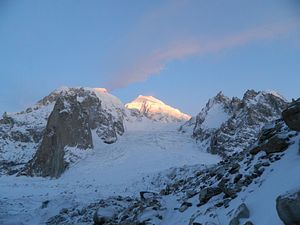Naik Hanamanthappa Koppad’s story gripped India last week. The country mourned the death of the soldier, who survived for six days under 35 feet of snow after an avalanche at the Siachen Glacier. He was miraculously found alive with a pulse, but died later of multiple organ failure in New Delhi last Thursday. With his death, Koppad was thrust from anonymity at the icy glacier, some 20,000 feet above sea level, to the top of India’s national consciousness. The avalanche claimed the lives of nine of his colleagues last week; the bodies of most of those soldiers remains buried under the snow.
The sheer scale of tragedy adds to the number of human casualties that India and Pakistan suffer with regular frequency in the inhospitable terrain of northern Kashmir. The ordeal their soldiers face raises the question of the feasibility of protecting this icy terrain. Koppad’s tragedy brings into focus the need to demilitarize the area, which has claimed and maimed more lives than the actual fighting between India and Pakistan. In 2012, more than 100 Pakistani soldiers and some civilians lost their lives in an avalanche. According to an estimate, more than 1,500 soldiers from both countries have lost their lives since 1984, when New Delhi captured Siachen from its western neighbor after a small skirmish. Since then, however, maintaining control of this difficult terrain has not been easy.
Experts differ on the strategic importance of the glacier, but they agree that the icy terrain has become more of a prestige issue for both India and Pakistan rather than a security issue. The non-delineation of a formal border between the two countries prevents the demilitarization of Siachen. This will not happen unless both nations demonstrate foresight and vision in handling the issue. Furthermore, as The Hindu noted in an editorial:
The demilitarization of Siachen is definitely doable. This is not only because it is diplomatically possible, but also because there is a critical mass of opinion in both India and Pakistan that neither can sacrifice, or put in harm’s way, so many lives on the inhospitable glacier. If the initiative is not seized by both sides now, the vagaries of nature will continue to exact a toll on forces deployed in Siachen, even if peace holds.
Several initiatives were made in the past to solve the Siachen issue, but the deep seated mistrust between New Delhi and Islamabad always came in the way. India is concerned about Pakistani and Chinese designs in the region and is wary of losing the strategic advantage of the Saltoro ridge in Siachen, lest its enemies capture Leh. Pakistan meanwhile sees India as an occupying force on the icy terrain and, therefore, fears reputational costs if it compromises with India.
Amid the ongoing dispute, the real victims are the soldiers. Is it worth losing so many lives for this terrain?
The death of ten Indian soldiers last week should serve as a rude awakening for both nations to move beyond their past perceptions and begin a serious process to demilitarize the Siachen Glacier. Koppad’s death has stirred India and has led to calls to do just this.

































